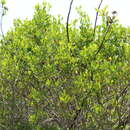Comments
provided by eFloras
Baccharis dioica is known from the southern tip of Florida. It is distinguished by its obovate, entire leaves with broadly obtuse apices, spreading phyllaries, and pappi that scarcely elongate in fruit.
- license
- cc-by-nc-sa-3.0
- copyright
- Missouri Botanical Garden, 4344 Shaw Boulevard, St. Louis, MO, 63110 USA
Description
provided by eFloras
Shrubs, 50–300 cm (much branched, bases woody). Stems erect, green, striate-angled, glabrous or slightly scurfy. Leaves present at flowering; short-petiolate; blades (1-nerved, lateral veins obscure) obovate to spatulate, 10–30 × 7–18 mm (somewhat fleshy), margins entire or occasionally with 1–2 short, broad teeth per side, bases tapering , apices broadly obtuse, submucronate or slightly retuse, faces glabrous, gland-dotted, sometimes resinous. Heads (in terminal clusters) in (leafy) corymbiform or paniculiform arrays . Involucres obconic; staminate 3–4 mm, pistillate 5–7 mm. Phyllaries ovate to lanceolate, 1–4 mm, margins scarious-erose, medians green, apices obtuse to acuminate. Staminate florets 20–30; corollas 3–4 mm. Pistillate florets 20–30; corollas 4–5 mm. Cypselae 1–2 mm, 8–10-nerved, glabrous; pappi 3–5 mm (scarcely elongating in fruit).
- license
- cc-by-nc-sa-3.0
- copyright
- Missouri Botanical Garden, 4344 Shaw Boulevard, St. Louis, MO, 63110 USA
Baccharis dioica: Brief Summary
provided by wikipedia EN
Baccharis dioica is a North American species of shrubs in the family Asteraceae known by the common name broombush falsewillow. It is native to Florida, the Yucatán Peninsula, and the West Indies (Bahamas, Greater Antilles, Virgin Islands, Montserrat).
Baccharis dioica is a shrub sometimes as much as 300 cm (10 feet) tall. It grows in hammocks, on dunes, and in mangrove swamps.
- license
- cc-by-sa-3.0
- copyright
- Wikipedia authors and editors

